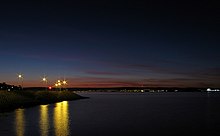
County Antrim is one of the six counties of Northern Ireland, located within the historic province of Ulster. Adjoined to the north-east shore of Lough Neagh, the county covers an area of 3,086 square kilometres (1,192 sq mi) and has a population of 651,321, as of the 2021 census. County Antrim has a population density of 211 people per square kilometre or 546 people per square mile. It is also one of the thirty-two traditional counties of Ireland.

County Down is one of the six counties of Northern Ireland, one of the nine counties of Ulster and one of the traditional thirty-two counties of Ireland. It covers an area of 961 sq mi (2,490 km2) and has a population of 552,261. It borders County Antrim to the north, the Irish Sea to the east, County Armagh to the west, and County Louth across Carlingford Lough to the southwest.

Larne is a town on the east coast of County Antrim, Northern Ireland, with a population of 18,853 at the 2021 census. It is a major passenger and freight roll-on roll-off port. Larne is administered by Mid and East Antrim Borough Council. Together with parts of the neighbouring districts of Antrim and Newtownabbey and Causeway Coast and Glens, it forms the East Antrim constituency for elections to the Westminster Parliament and Northern Ireland Assembly. The civil parish is in the historic barony of Glenarm Upper.
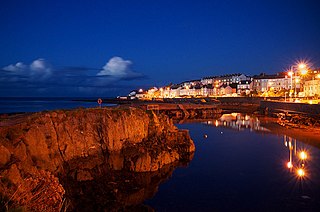
Bangor is a city and seaside resort in County Down, Northern Ireland, on the southern side of Belfast Lough. It is within the Belfast metropolitan area and is 13 miles (22 km) east of Belfast city centre, to which it is linked by the A2 road and the Belfast–Bangor railway line. The population was 64,596 at the 2021 Census. Bangor was granted city status in 2022, becoming Northern Ireland's sixth city.

North Down Borough Council was a Local Council in County Down in Northern Ireland. It merged with Ards Borough Council in May 2015 under local government reorganisation in Northern Ireland to become North Down and Ards District Council.

Holywood is a town in the metropolitan area of Belfast in County Down, Northern Ireland. It is a civil parish and townland of 755 acres lying on the shore of Belfast Lough, between Belfast and Bangor. Holywood Exchange and Belfast City Airport are nearby. The town hosts an annual jazz and blues festival.

Carrickfergus Castle is a Norman castle in Northern Ireland, situated in the town of Carrickfergus in County Antrim, on the northern shore of Belfast Lough. Besieged in turn by the Scottish, native Irish, English, and French, the castle played an important military role until 1928 and remains one of the best preserved medieval structures in Northern Ireland. It was strategically useful, with 3/4 of the castle perimeter surrounded by water. Today it is maintained by the Department for Communities as a state care historic monument, at grid ref: J4143 8725.
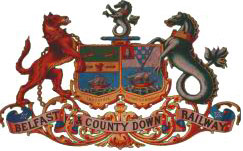
The Belfast and County Down Railway (BCDR) was an Irish gauge railway in Ireland linking Belfast with County Down. It was built in the 19th century and absorbed into the Ulster Transport Authority in 1948. All but the line between Belfast and Bangor was closed in the 1950s, although some of it has been restored near Downpatrick by a heritage line, the Downpatrick and County Down Railway.
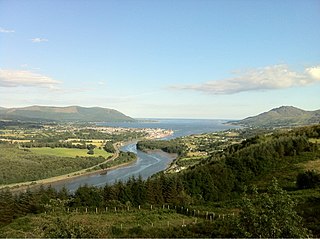
Carlingford Lough is a glacial fjord or sea inlet in northeastern Ireland, forming part of the border between Northern Ireland to the north and the Republic of Ireland to the south. On its northern shore is County Down, the Mourne Mountains, and the town of Warrenpoint; on its southern shore is County Louth, the Cooley Mountains and the village of Carlingford. The Newry River flows into the loch from the northwest.

Larne Lough, historically Lough Larne, is a sea loch or inlet in County Antrim, Northern Ireland. It lies between the Islandmagee peninsula and the mainland. At its mouth is the town of Larne. It is designated as an area of special scientific interest, a special protection area, and a Ramsar site to protect the wetland environment, particularly due to the presence of certain bird species and shellfish.

Greenisland is a town in County Antrim, Northern Ireland. It lies 7 miles north-east of Belfast and 3 miles south-west of Carrickfergus. The town is on the coast of Belfast Lough and is named after a tiny islet to the west, the Green Island.

The Ulster Folk Museum and the Ulster Transport Museum are situated in Cultra, Northern Ireland, about 11 kilometres (6.8 mi) east of the city of Belfast. The Folk Museum endeavours to illustrate the way of life and traditions of the people in Northern Ireland, past and present, while the Transport Museum explores and exhibits methods of transport by land, sea and air, past and present. The museums rank among Ireland's foremost visitor attractions and is a former Irish Museum of the Year. The location houses two of four museums included in National Museums Northern Ireland.

Cultra is an affluent residential neighbourhood near Holywood, County Down, Northern Ireland. It is part of Greater Belfast. It is in the Ards and North Down Borough Council area.
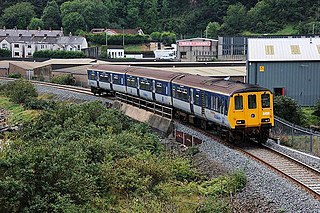
The Belfast–Larne line, or Larne line, is a railway line in Northern Ireland, operated by Northern Ireland Railways. It runs as double track along the majority of its route north along the scenic east Antrim coastline from Belfast to the coastal seaport town of Larne, serving commuters and ferry passengers.

Cultra railway station is a railway station in the townland of Ballycultra in Holywood, County Down, Northern Ireland. It serves the Cultra residential area and the Ulster Folk and Transport Museum.

The Belfast suburban rail commuter network serves the metropolitan area of Greater Belfast and some of its commuter towns with three lines. The network is owned by Translink and operated by its subsidiary NI Railways.
Belfast Lough Yachting Conference (BLYC) is a group that encompasses the yacht clubs on Belfast Lough and Larne Lough in Northern Ireland. Its primary aim is to look after scheduling the regattas that each club host, to try to prevent clashing events. Member clubs within the conference include:
Transportation systems in the city of Belfast, Northern Ireland, include road, air, rail, and sea. It is still a relatively car-dependent city; however, it is also served by a comprehensive rail and bus network. Belfast also ran electric trams prior to 1954. The city has two major airports, and the Port of Belfast is the busiest ferry port on the island of Ireland.
Ulster railways, present and past, include:

The siege of Carrickfergus took place in August 1689 when a force of Williamite troops under Marshal Schomberg landed and laid siege to the Jacobite garrison of Carrickfergus in Ireland. After a week the Jacobites surrendered, and were allowed to march out with the honours of war.



